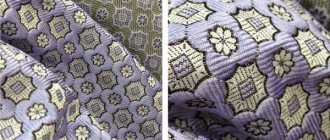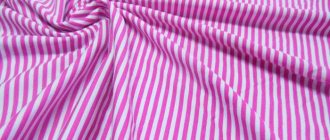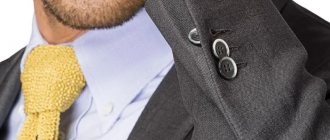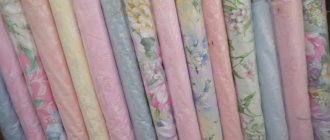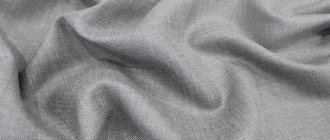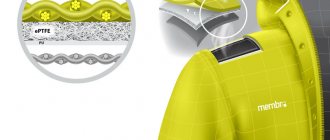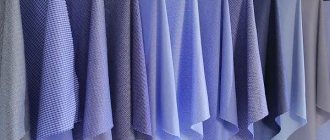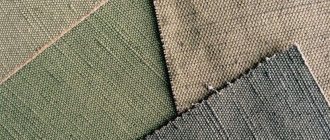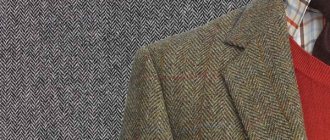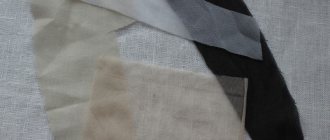Description of interlock
Interlock - what kind of fabric? It is a cotton knitted fabric. It has a dense structure and does not stretch well. This is achieved through a special double-sided weave. It is also called dvulastic. The fabric is equally smooth on both sides. The fabric has no outside or back side. However, with special processing, vertical stripes can be achieved.
Interlock is divided into three types depending on quality. What kind of fabric is this?
- Penye cotton (high quality), the fabric is made from long-fiber raw materials, it has an exceptionally smooth surface;
- Ring or card (this is good quality), medium-length fibers are used in production;
- Oppenend (low quality), made from short-staple cotton raw materials.
The presentation of the fabric and the finished product depends on the grinding of the thread and the raw materials used to form the fabric. Of course, based on this, the final price is determined. Despite the fact that manufacturers usually indicate the high quality of interlock, you can verify the correctness of this characteristic by simply carefully examining the fabric itself. The higher the quality, the fewer fibers and irregularities there will be on the surface of the fabric.
Interlock: which type to choose
There is an international classification of cotton knitwear, which is based on the quality of the finished product and its external characteristics. The canvas comes in 3 varieties:
- Peña. It is made from long cotton fibers, which are sanded during the production process. The fabric is dense, even, smooth, silky to the touch, seems polished. Has no flaws or irregularities. Does not pill, does not wrinkle, is resistant to deformation and retains heat well. Belongs to the highest category.
- Ring (another name is card). It is made from medium-length fluffy fibers with a smooth structure. Differs in lower density. The material is loose but durable, strong but lightweight.
- Openend. Soft, fluffy knitwear of low quality. The raw material is loose, short threads. Roughness and unevenness are noticeable on the surface. This is the most budget option.
Sometimes manufacturers indicate the name of the fabric “penye” on the label. This is a common marketing ploy. The material may not always fall into this category. If you come across such a label, be sure to carefully inspect the product, try it by touch, and evaluate its tactility.
Manufacturing
Read about: crepe de Chine fabric: when femininity is in fashion.
According to the knitting method, interlock refers to double knitwear. The fabric is made by weaving threads. They continuously bend into loops, connecting with each other. The loop is the basis of knitting. Its main elements are the broach and the skeleton. The latter has looped sticks and arcs. Loop rows are elements located horizontally, the columns have a vertical orientation.
The material belongs to derivative cross-knitted weaves. This look is obtained by combining two or more main weaves of the same type. Thanks to this combination, the derived type has a higher density. Loop columns have smaller spaces. This has a positive effect on the characteristics of the final product. It has less horizontal extensibility, greater density, and also does not unravel so much when the threads break.
It is a combination of two erasers that are connected from the inside out. As a result, it is impossible to distinguish the inner and outer sides of this canvas. To knit an eraser, alternate knit stitches with purl stitches. This combination can be different:
- through one column 1+1;
- through two columns 2+2;
- two knit and one purl 2+1.
Interlock characteristics
Durability and ease of use depend on quality characteristics. Among the main parameters of cotton knitwear are:
- Density. It is close to the indicators of erasers and ranges from 190 to 220 g per square meter.
- Thickness. It is calculated using the formula t=4dh. In this case, dh is the diameter of an individual thread.
- Extensibility. The double elastic belongs to group 3 of fabric elongation, that is, it is more than 100%. But there is one nuance here. This indicator is greater in width than in length. At the same time, when stretched, the length and thickness of the fabric decreases. But the material always returns to its original form.
- Strength. It also varies in length and width. The strength of the fabric is determined by the formulas: Pg=4q (lengthwise), Рш=2q (width). G is the strength of a single thread. Interlock is resistant to mechanical damage and practically does not tear.
- Bloomability. You can unravel the double elastic only in the direction opposite to knitting. Even if the thread breaks, the product does not unravel, because, thanks to a special weaving method, the load from the damaged loop column is transferred to another column with an unbroken thread system.
Due to their high density, interlock items are not suitable for the summer season. It is recommended to choose lighter knitwear.
Description of interlock fabric
- Density 180-220 g/sq.m. m..
- Smooth, pleasant to the touch double knit fabric on both sides.
- In production, two rows of knitting equipment needles are used.
- A special weaving process produces fabric that is the same on both sides, without a face or back.
- Does it stretch or not: yes, but only in width.
To make knitted fabric, yarn with a weak twist is used. Before starting the knitting process, the threads are rewound and treated with paraffin. Then an emulsion is applied to them. This gives it a smooth feel.
When using fibers of different colors, checkered or striped fabric is obtained. Printed double elastic is produced by applying paint to the surface, each color separately.
Plain-dyed interlock is painted before the fabric is made. The threads are dyed separately so that the color is uniform. The result is a bright, plain fabric.
To create interlock, double knitting machines are used. They contain two needle beds, fixed at an angle to each other. On round versions this angle forms 90 degrees, on flat-jointed ones - about 100 degrees. Mechanisms are produced where the angle forms 180 degrees.
The needles on the mechanisms are arranged in two rows. They can function simultaneously or follow each other. But how do you get a canvas that is the same on both sides?
This becomes possible due to the fact that the needles of each needle bed slip between each other, throwing off the loops. These designs use hook and tongue options. Devices that have both of these types in each needle bed are especially valued. However, round mechanisms with reeds are still most widespread. Let's talk about the process of making interlock using them.
Manufacturing process
Includes the following steps:
- Conclusion;
- Laying;
- Pressing;
- Carrying out, applying;
- Connection, cooldown, drop;
- Shaping, pulling.
To begin with, the needles are installed. Then the vertical needle is set in motion along the stationary thread guide. She moves down, picking up the thread. The former loop is guided along the needle shaft and passes under the reed mechanism, which closes as the needle moves further. In this case, the horizontal needles remain motionless. When applied and combined on vertical needles, pressing and removal occurs on opposite elements.
After the last previous loops are dropped, the horizontal needles are pulled back and the thread is pulled through the worked loops. After dropping the loops on the horizontal needles, alignment and formation of new ones occurs. At this stage, the vertical elements form double loops. Loops of a horizontal needle are created from them. This method of forming loops is called distributive.
Interlock can also be created on flat and flat-joint machines. In the latter, the process of loop formation occurs without distribution. At the moment, factories are equipped with semi-automatic flat-joint machines, on which all operations are adapted. The only exception is when the needles are turned off. This process must be started manually.
Manufacturing technology
Weaving of the material is done on special machines in which several needles are installed at certain angles. The manufacturing technology consists of the following steps:
- The fibers are initially treated with paraffin and a special emulsion. This impregnation gives the material smoothness.
- The threads are twisted and wrapped together so that full loops are obtained.
- The main formation is obtained through a light weave of light satin threads, which are called eraser.
Note! This type of material is not woven, but knitted, since the fibers are intertwined with each other through interlacing loops.
Interlock production workshop
Interlock weaving can be multi-colored. To form a specific print, multi-colored threads are used. A specific pattern is applied using the printing method (interlock printing) - the fibers of the finished fabric are colored.
Characteristic
Interlock is an interesting fabric.
- It is soft and dense at the same time, and also very warm and wear-resistant. Externally, dvulastic can be distinguished from other knitted weaves by its characteristic ribbed pattern. Its density ranges from 240 to 330 g/sq.m.
- Despite the fact that interlock has a smooth surface on both the front and back sides, you can find brushed versions of this fabric on sale.
- It retains heat perfectly while ensuring free air circulation. This allows you to maintain a comfortable body temperature without fear of overheating.
Read about: crepe chiffon is a wonderful look in every item.
By weaving threads of different colors you can achieve striped or checkered fabric. To give an additional shade, a printed dyeing method is used. With this application method, each color is transferred to the surface separately. When applied, new shades may form. The most common method used is direct printing. When using it, dyes are applied to bleached or dyed fabric in the desired areas.
The “correct” interlock is made from pure cotton. However, some manufacturers may also add artificial fibers to the composition.
Pros and cons of interlock knitted fabric
Interlock has a “thick” weave. This is reflected in the characteristics of products made from it. Positive qualities of interlock:
- Wear resistance, abrasion resistance. The fabric does not fray. What does this mean: it does not become covered with pellets.
- The color remains vibrant after many washes.
- Soft, but dense and durable material. Pleasant to the touch.
- Allows air to circulate freely. Absorbs moisture. The skin feels comfortable.
- Interlock is an unpretentious material and does not require complex care. If you follow the manufacturer's recommendations, it will last a long time.
- Does not deform. After stretching, it quickly takes shape. The threads do not stretch, and no puffs or arrows are formed.
- Eco-friendly fabric made entirely from natural materials.
- The fabric made in this way does not unravel.
- High product density.
- It has good “warming” qualities.
- Keeps its shape well.
- Hygiene.
- Do not cause allergies.
- Increased product elasticity.
The negative aspects include:
- slight elasticity, not in length, but in width;
- in hot summers it is unpleasant to wear due to the density;
- When washing, the double elastic shrinks along its length if the water temperature is high.
- High degree of permanent deformation.
When used correctly, the advantages outweigh the disadvantages.
Properties
- Extraordinarily durable material. This property is ensured by the best raw materials and special knitting technique.
- The clothes keep their shape perfectly. Of course, knitwear is not as elastic as its counterparts, in the manufacture of which artificial materials are used, but it still stretches and then quickly takes its original shape. For those who are interested in cotton materials with the addition of synthetic fibers, in our other article you can read about the interesting material cashcorse, where, in addition to cotton, a small amount of lycra is used.
- Products made from this knitwear can be worn for a very long time; you will get tired of the item before it becomes unusable. Puffs and pilling are anything but signs of interlock knitwear
- The material does not require special care, it is enough to wash things as recommended by the manufacturer (however, about the features of care - a little lower)
- What is interlock fabric if not one of the most environmentally friendly materials - this fabric will not provoke allergic reactions or cause irritation. In addition, it perfectly allows air to pass through and absorbs moisture;
More on the topic:
- Size chart for children's clothing by age and height;
- US children's sizes on Aliexpress (table);
- Sizes of newborns by month (table);
Products
What is sewn from interlock:
- Tracksuits.
- Robes, pajamas, home suits, nightgowns. They are dense, soft and weightless, so they will not create discomfort during sleep. Clothing made from such fabric will not be felt on the body at all.
- Casual knitted clothing - sweaters, sweatshirts, shirts, T-shirts;
- Dresses, skirts;
- Bed sheets.
What can you sew for a child:
- hats, rompers, vests;
- bed and underwear;
- Stuffed Toys;
- school uniform.
It is absolutely harmless. This is an excellent material for sewing clothes even for the little ones. Not every type of fabric can be used to make any clothing. For everyday items, underwear, high-quality fabric is used.
Application area
Interlock has a wide range of applications, but most often it is used to sew sportswear:
- Turtlenecks with a high neck.
- Tracksuits of various configurations.
- Skirts and trousers of a sports cut.
- Dresses and sundresses.
- T-shirts, tennis shirts, tank tops.
- Home costumes.
In addition to clothing, textiles can be used to make covers for chairs and armchairs. Interlock makes excellent cases for finishing fragile items.
Application area
Sewing from this type of material is quite simple. During the cutting process, the threads on the cuts do not fray, and the fabric is not deformed.
Types of material
There are three varieties:
- Peñe quality, which means: this is the best type of knitwear. It is made from long fibers of the highest quality. Interlock singing, what kind of fabric is it - smooth and silky to the touch. There is no roughness, lint, or pellets. An elegant dress made of interlock should be of pennie quality.
- Ring (carde) is made from medium-sized threads. It turns out looser than peñe cotton, but remains quite smooth. Less density.
- Open end is knitted from the shortest fibers. There is fluffiness and unevenness. Synthetic fibers are often added to the openend. It is used to make home and sleeping clothes.
On a note
Important: when purchasing, you should inspect the canvas. Even if it says “sweet”, but it is rough to the touch and fluffy to the eye, it means it’s a cheap alternative. A good interlock knit should be smooth.
Types and colors
According to the international classification, cotton knitwear is divided into 3 types:
- singing;
- ring (card);
- open end.
The fabric dyes well, holds color for a long time, can be plain or with patterns and pictures. Types of material by color:
- Plain. The color palette includes bright colors for weekend outfits and soft pastel colors for sewing children's and home clothes.
- Melange color. Threads of the same color are used, but in different shades. There is often a gradient - a soft transition from one shade to another.
- Printed - the pattern is applied not over the entire canvas, but in certain areas. It is applied to the finished canvas using the printing method.
- Checked and striped. Obtained by knitting with threads of different colors.
Separately, a synthetic or semi-synthetic version of the fabric is distinguished. Microfiber is a polyester knitwear created using interlock weaving. Elastic, durable, velvety, wears well. The material is used to make tracksuits, T-shirts, and soft toys of the “anti-stress” series.
Peña
The highest category of fabric. Made from the longest cotton fibers, which are pre-sanded. The canvas is even, dense, absolutely smooth, without the slightest pellets, lint, irregularities, or knots. When touched, it feels silky.
When worn, it does not wrinkle, does not pill (no pills form), and retains heat perfectly. Most often, interlock type penye is used for sewing underwear, nightgowns, pajamas, and children's clothing. High-quality sports suits, sweaters, hats, and sweatshirts are made from denser materials.
Ring (card)
To make ring fabric, or carde, the manufacturer uses medium-length cotton fiber. The material has a slightly lower density, more loose, but at the same time durable and lightweight. Cardet is used for sewing knitted clothes of average quality.
Openend
The material is of the lowest quality and the cheapest price tag. It is made from short and loose fibers, as well as thread remnants after knitting pene and carde.
The fabric is soft, not dense. The surface is uneven, rough. Due to the large number of short fibers, this fabric is fleecy.
Difference from other materials
It is often confused with the following fabrics:
- Footer – smooth or brushed on the inside. Lycra, wool, and polyester are added to it. Footer and interlock, difference: made of two or three threads, footer is denser and warmer than double elastic. But it stretches worse and deforms more easily.
- Cashkorse has the same density. Composition – 100% cotton, or add up to 10% lycra, polyester, elastane. When knitting, alternate purl and knit stitches 2x2 or 3x3. The texture is knitted, smooth. The cost is between a cooler and a double-last.
- Kulirka or interlock, which is denser? The cooler is thinner, 145-180 g/m2. m. Differences between a kulirka and a double-strap: on the outside of the kulirka (suprema), a braided braid is obtained. The reverse side looks like brickwork. It costs less.
Which is better, cooler or interlock: it depends on the specific product and season. Supreme is suitable for the warm season, for making delicate items, for children and adults. Warm knitwear makes you feel more comfortable in the cold.
Caring for interlock products
Caring for knitted items will not be difficult if you follow these tips:
- It is better to hand wash products at a temperature of 40 degrees or in a machine on a delicate program.
- The detergent must not contain chlorine. Use soft powder or liquid detergent.
- Does the fabric shrink when washing: yes, if the temperature is above 40 degrees. For minor stains, 30 degrees is sufficient.
- When washing, use mild detergents.
- It is recommended to remove stains from the product and treat it before soaking.
- Squeeze carefully with your hands, without twisting. The machine is set to the minimum number of revolutions.
- Colored and white items are washed separately.
- Be sure to use conditioner when rinsing. It will maintain the structure and softness of the fabric.
- Interlock cotton is ironed from the wrong side.
Store items neatly folded on a shelf or hung on hangers in a closet.
Soft and pleasant double elastic is used to make various things. You can use it to sew clothes for the whole family.
Advantages and disadvantages
Interlock material has advantages and disadvantages regarding properties, care, and use. The undeniable advantages are the following facts:
- If mechanical damage occurs to the textile, the fabric will not unravel further.
- The flexibility and possibility of deformation of the fabric makes it suitable for wearing during periods of increased physical activity.
- It does not wrinkle when worn or left in the closet for a long time, so a carelessly thrown blouse can be worn without the need for re-ironing.
- Thanks to high-quality dyeing of the fibers, the fabric retains its original color for a long time.
There are also some disadvantages that are not significant:
- The sufficiently high density makes interlock unsuitable for wear in too hot weather.
- If one of the washing rules is not followed, the fabric will be completely damaged beyond repair.
- Uncertain direction of fiber stretch, which can create problems during wear.
Positive and negative properties
There are more advantages than disadvantages. Plus, clothes made from this type of material are comfortable and practical to wear.
You might be interested in what karkul and swakara are: from which animal fur are materials made?
Reviews
Veronica, 38 years old: I once bought a children’s suit and couldn’t be happier. Soft, does not provoke our constant allergies. Now I take all my household items, even for myself, from this knitwear.
Elena, 52 years old: I always take bed linen and a shirt from knitwear. But in the summer it’s hot in dense conditions, the ideal option is a cooler.
Vladimir, 21 years old: my younger sister and I bought identical knitted pajama suits for home. Now we only wear them.
Double elastic is an interesting fabric. Thanks to double weaving, they acquire amazing strength and density, without creating a feeling of “chain mail” on the body. This is an environmentally friendly material, as it is based only on cotton. It does not cause allergies or discomfort even with prolonged wear. Currently, this is the most popular material for sewing children's clothes. If you see this name on the label, you can buy it with confidence!
© 2021 textiletrend.ru
